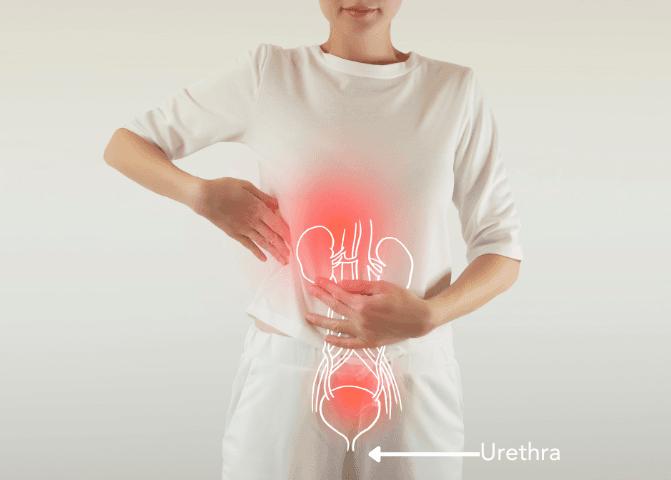23/10/2023
What Causes UTI in Women? A Quick Guide
Why do women get more UTIs? A urinary tract infection (UTI) is a bacterial infection occurring anywhere in the urinary tract. This can mean an infection in the upper urinary tract (i.e., kidneys, ureters) or, as in most cases, the lower urinary tract (i.e., bladder, urethra). These are due to the migration of normal bacteria such as Escherichia Coli (E.coli) and Klebsiella from the area in and around the rectum and anus toward the urethra. The bacteria climb up the urethra and enter the bladder. From here the bacteria can invade the bladder wall causing inflammation in a process called bacterial cystitis. This article will deal with lower urinary tract infections in women.
What causes UTI in women?
Women are affected by UTIs more frequently than men with 1 in 10 women having an infection once per year and approximately 50% of women experiencing a UTI at least once in their lifetime. Women are affected four times more frequently by UTIs than men and are more likely to have recurrent UTIs. But why is this the case?
For the most part it is anatomical. In females the urethra is between 3-4cm long and travels from the bladder to the external opening of the urethra located in the perineum, nearby to the entrance of the vagina not far from the rectum and anus. In males the urethra is between 15-20cm in length with the external opening at the tip of the penis.
The location of the external urethral opening in females allows the bacteria which normally live in the perineal and anorectal space easier access to the urethra and therefore, the bladder. The bacteria that cause UTIs have less far to travel through the female urethra to arrive in the bladder than they do in males.
The most common risk factor for development of UTIs in women is sexual intercourse. This occurs by physically increasing the contact between perineal bacteria and a woman’s urethral opening. More frequent urination, high volumes of urine and complete bladder emptying are believed to decrease the risk of a UTI. And so, it is recommended to urinate as soon as practical after sex to flush out possible UTI causing bacteria.
Other risk factors include the use of contraceptive diaphragms and spermicides which can cause urinary stasis and alter the perineal micro-environment making it more likely for bacteria to stick to cells in the urethra. Any other physical or physiological factors that affect normal bladder emptying can also pre-dispose a woman to having UTIs i.e., a urinary catheter, atrophic vaginitis, cystocoele.

Women have a short urethra, increasing risk of UTI.
What are the symptoms of UTI in women?
UTIs are generally grouped as either uncomplicated or complicated. An uncomplicated UTI occurs in the bladder of an otherwise healthy female who is not pregnant and who is not known to have any urinary tract abnormality. Complicated UTIs are those that occur in women who are pregnant, who have other significant health issues, who have any urinary tract abnormality, all upper urinary tract infections and any UTI that occurs in a male.
The most common symptoms of an uncomplicated UTI are;
- pain while passing urine (dysuria)
- frequent urination (frequency)
- sudden need to urinate (urgency)
- difficulty with starting to urinate (hesitancy) and
- blood in the urine (haematuria)
Other symptoms may be present and could include cloudy offensive smelling urine or pain and discomfort in the lower abdomen overlying the bladder, urethra or vagina.
Usually, patients presenting with an uncomplicated UTI do not have symptoms of fever, chills, nausea, vomiting or pain in the back/flanks which are all signs of a possible upper urinary tract infection involving the kidneys although it is not always clear cut.
How long does a UTI last?
The duration of a UTI can vary from person to person, the severity of symptoms and can depend upon how the infection is managed. Mild UTIs might last between 5-7 days when treating the symptoms only with simple pain relief, increasing fluid intake and urinary alkalinising agents such as Ural.
If you have been prescribed antibiotics, then you can expect to start feeling better with an improvement of symptoms within 24-48 hours of starting your medication. If you are still having significant, worsening symptoms or you develop 48 hours after starting antibiotics then you should have an urgent review with a doctor for further investigation and treatment.
What treatments are available for UTI?
Treatment depends upon the severity of symptoms and patient factors such as other health issues, pregnancy, male sex and so on. In about 20% of women, mild UTIs will resolve spontaneously. Symptoms of a mild and uncomplicated UTI might be managed with medications like panadol and/or nurofen alongside a urinary alkaliniser such as Ural.
If this does not improve symptoms, if symptoms worsen or new symptoms develop, then speaking to a Medmate online doctor or seeing a doctor would be important and medical treatment might be prescribed. For uncomplicated UTIs, your doctor may request a sample of your urine to check for signs of a UTI. It is then sent for testing to see what bacteria grows and which antibiotics the bacteria respond to.
While awaiting the results of the urine test your doctor may start you on an initial treatment which kills the most likely bacteria causing the infection. It is very important that the treatment course is completed even if you start to feel better. This ensures that the infection is fully treated and prevents development of bacterial resistance to the treatment.
In cases of complicated UTI your doctor may request a urine sample for testing as well as other tests to investigate the cause for your UTI. Some people with urinary symptoms will develop signs and symptoms of an upper urinary tract infection called pyelonephritis. This is where the kidney becomes involved in the infection and this type of infection may require intravenous ttreatment.
Unfortunately, despite adequate treatment, some women go on to experience recurrent UTIs. A recurrent UTI is defined as >2 episodes within 6 months or >3 episodes within 12 months with significant bacteria counts in the urine when tested. In this situation, your doctor will order urine tests, imaging of the urinary tract and may refer you to a Urologist for further evaluation.
Conclusion
Urinary tract infections, particularly those involving the bladder, are a common infection. Women are much more likely than men to be affected by UTIs with common symptoms including painful urination, frequent urination and difficulty starting to urinate among others. Many UTIs are uncomplicated and may only need symptomatic management with simple over the counter medication while they resolve. More often uncomplicated infections will require medical treatment to resolve, and symptoms should improve within 24-48 hours of starting treatment. For UTIs in men, pregnant women and people with significant health problems or recurrent UTIs, discussion with your doctor is crucial to allow appropriate investigation and treatment to prevent long term negative health outcomes.
Talk to an Online Doctor Today!
Stay on top of your health. If you have any symptoms of a UTI, speak to an online doctor today with Medmate by booking a same day consultation.
References
- Bono MJ, Leslie SW, Reygaert WC. Urinary tract infection – statpearls – NCBI bookshelf [Internet]. StatPearls Publishing; 2023 [cited 2023 Oct 22]. Available from: https://www.ncbi.nlm.nih.gov/books/NBK470195/
- McKertich K, Hanegbi U. Recurrent UTIs and cystitis symptoms in women. Australian Journal of General Practice. 2021;50(4):199–205. doi:10.31128/ajgp-11-20-5728
- Chung A. Bacterial cystitis in women. Australian Family Physician. 2010 May;39(5):295–8.
Recommended reading
Search for a specific topic or filter by categories to find information on what you need to know on the full Medmate Journal


The Belt Squat RDL is a Game-Changer
Looking to build a stronger, more powerful lower body while minimizing risk? The Belt Squat RDL might just be the exercise you’ve been missing. This unique movement, often overlooked, offers…